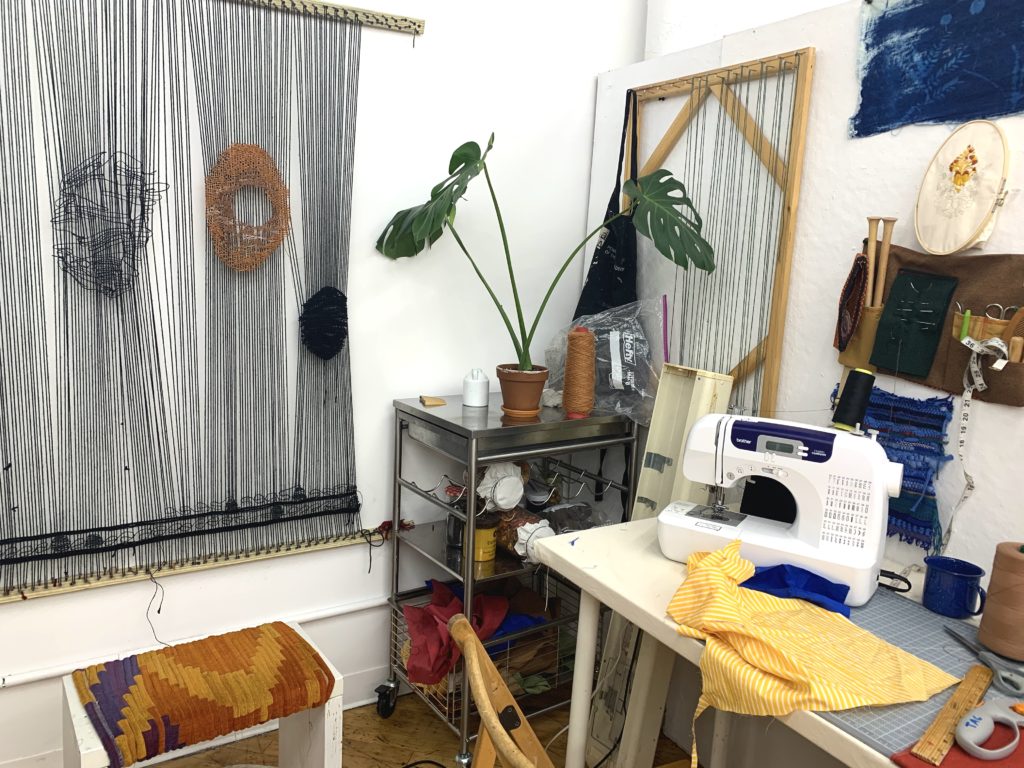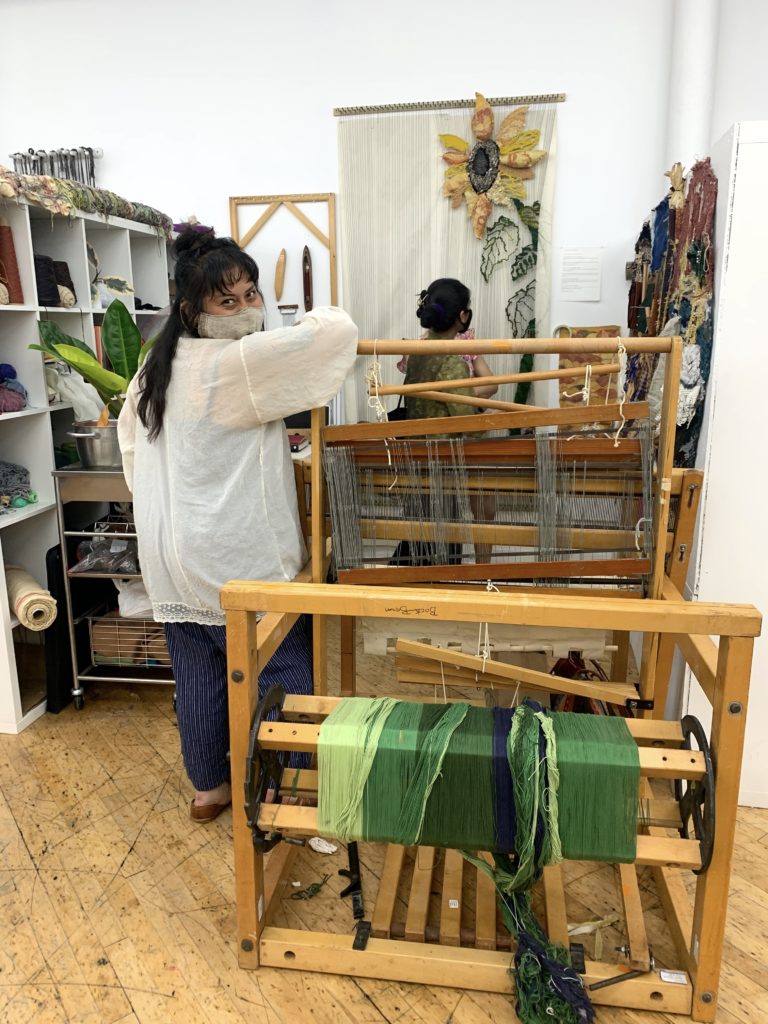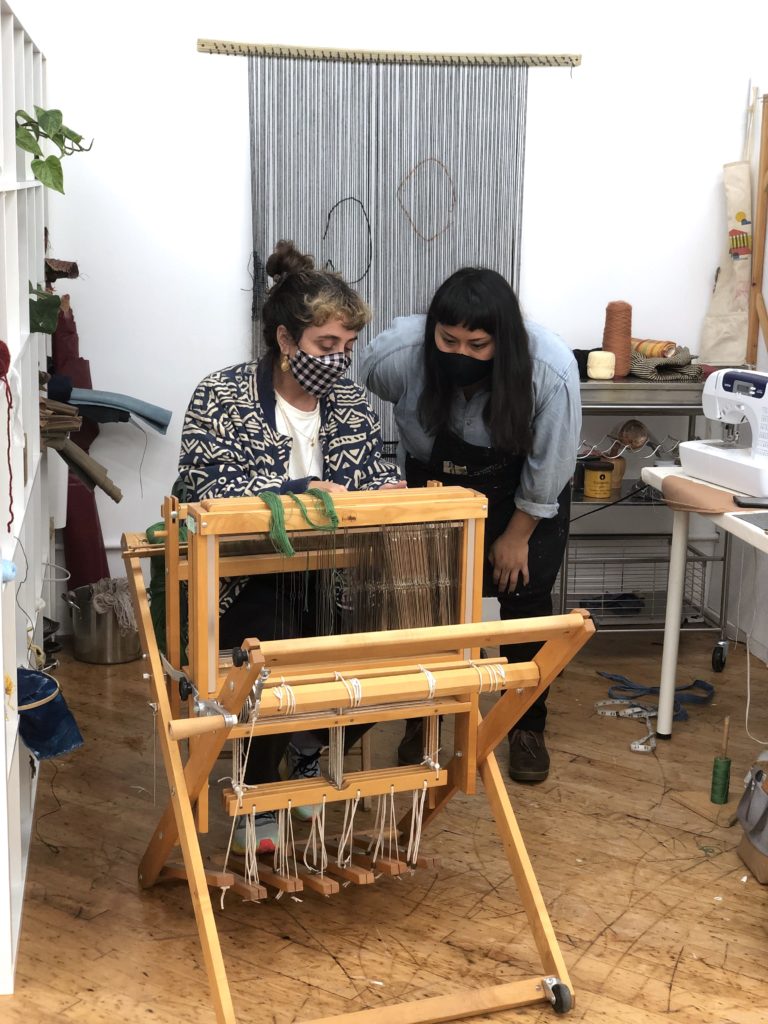AIR Highlight: Jessica Elena Aquino
This conversation took place on June 28, 2021 at the Textile Arts Center with Jessica Elena Aquino and Isa Rodrigues.
Video Visual Description:
Footage of Jessica Elena Aquino, wearing a light denim shirt, with her dark brown hair down, and light grey face mask. In the foreground on the right hand side is the blurry silhouette of Isa’s light face and dark curly hair. The conversation is happening in Jessica’s studio at the Textile Arts Center, and Jessica and Isa are sitting across from each other, next to a floor loom. In the background, on the wall, there is a large scale frame loom with weaving in progress, depicting a sunflower surrounded by a nature inspired scene. Some points of the video span around the work in progress weaving, showing technique and material details.
Jessica Elena Aquino (she/they) is an interdisciplinary fiber artist, educator, and poet from Santa Ana, CA, currently based in Brooklyn. Aquino uses improvisational weaving, sculpture, and the use of childhood & cultural objects to navigate her (dis)connection to familismo, home, love, and labor. Aquino intertwines poetry, plant dyeing, and biographical and historical research, to provide a space of healing. She sits in discomfort in unweaving forms of heartache, intergenerational trauma and finding catharsis by working with the earth itself.
Jessica Elena Aquino (b.1991) earned her B.A in Studio Art in Painting from Colgate University in 2014 and an MFA at the PA Academy of the Fine Arts in 2019. Her work has been exhibited at the Barrett Arts Center in Poughkeepsie, NY; Pilot Projects, PA; The Plastic Club; The PA Academy of the Fine Arts; Marginal Utility, and Anna Zorina Gallery. Aquino has been invited to participate in Manufactured Narratives at the Urban Institute for Contemporary Arts in Grand Rapids, MI in January 2022. She was an Artist in Residence at the Santa Fe Art Institute, Textile Arts Center in Brooklyn NY, and Chautauqua School of Art's Residency program. Aquino has won numerous awards such as the Murray Dessner Travel Grant. Aquino has a background in education working for the PA Academy of Fine Arts, Philadelphia Museum of Art, and Museum of Modern Art, in Manhattan, NY.
Isa Rodrigues (she/her) is the co-Executive Director of the Textile Arts Center
Isa: Hi Jess! Thank you for having me in your studio. I always love being here, it always looks so warm, and with the plants, it’s like a vacation. Before we start, would you like to introduce yourself and maybe tell us a little bit more about your practice?
Jessica: Sure! My name is Jessica Elena Aquino, I am from Santa Ana, California. I am a multidisciplinary fiber artist, mostly working with objects, different materials, and also poetry in my work.
Isa: When did you start working with textiles and what drew you to experiment with fiber materials and techniques in your work?
Jessica: So, I started working with textiles and fibers when I was in my second year in graduate school. Beforehand, I had come in as a painter but I had started to become a little frustrated with painting. I no longer felt like the paint brush was serving me, it was no longer a part of my extension of the hand. And because I had already worked on the farm for three years beforehand, I was really used to working with my hands, with touching soil, you know, just more textural things. So it kind of felt like.. I didn’t even expect it to happen, but a lot of my critics started to encourage me to pick up materials, to touch paper, to see how the materials that I was working with, painting, like paint actually touched and molded and what does that do.
So, that just kind of threw me to work with these materials but also I wasn’t initiated into the fiber world until I went to Mexico. I was very privileged to be rewarded with this grant from my graduate school to go to Teotitlán del Valle, Oaxaca, Mexico. And there I would learn from the Zapotec community how to use a floor loom but also how to dye with plants. And that just opened up a whole different world because now I was involved with the two worlds that I love, which is art and nature, and that just set the stage for what is now.

Isa: I feel like you did that residency right before TAC, right? You’re arriving with these recent explorations on the floor loom and natural dyeing, and I remember the first months you were really focusing on also continuing that exploration. And nine months later, I think you’ve jumped from all types of looms we have here at TAC, you’ve experimented with so many different textile techniques, but to really hone your practice. I feel like you’ve arrived at something that is very much like Jess’ gesture and approach to technique, that definitely combines these painterly elements and heavy materiality. Do you want to speak maybe a little bit more about your current approach to your work and how you’re using weaving as a technique?
Jessica: For sure, I think I still hold on to certain painterly elements, for instance, the use of color, more heart tones, that’s like my palette to go-to. But also, because I work more now on the frame loom rather than the floor loom, it’s been more of a comfort for me to see the whole picture, rather than a small segment of it at a time, which then tells me I am a big picture person (laughs). Like the canvas, I get to move around, and that’s also a part of it. I think I started to realize being here in the past nine months, just how much I really enjoy my body being the other element of that practice, that it’s not just weaving, or sitting down, or sketching, but it’s now.. the body. And how it moves, and how it moved when I was working in the farm, and how it moved when I was painting. So, definitely those elements are still there. And the whole style that I’ve created for myself, I really have enjoyed to look up the artists before me, like how they were doing alternative forms of weaving, that it wasn’t just compacted tapestries, to really hone in the techniques that I enjoy and that bring me a form of texture. And that, in some ways, manipulates the lines that always, I think, was part of my practice, line work.

Isa: Over the last nine months, you’ve been doing so much material and technique exploration, but also a lot of research into new concepts, but also into a new body of work. Can you share a little bit more about what has been the focus of your practice over the residency?
Jessica: Yeah. So, coming here I had already known that I did want to bring back poetry. So a lot of..I don’t want to say research, because I feel like research is so intellectual or associated with intellectual. So a lot of it was a lot of personal growth. And getting back into things that really have interested me in the past, that I haven’t had the time to actually look into, so that was into my family past. My family’s history, you know, our relationship with labor, our relationship with nature. So holding a lot of conversations with my family, that’s been my research. But I also feel like it’s so detached when you talk about it in that way. So it’s a lot more personal, getting into the most vulnerable places with them, and with myself. So that’s been a lot of the focus. And again, bringing back poetry. I fell off the wagon for a while (laughs), but I also wanted to find ways that I can, you know, if I’m calling myself multidisciplinary, which I feel that’s right, but also the different things that I enjoy expressing myself in, so one of them is poetry. So how can I include poetry in my work? Like, would it be in the actual work? Would it be inspired by another piece? Right now, some of the pieces are named after some poems that I write. So every time I finish a new piece I write a poem after them, or beforehand. So yeah, exploring those themes of, I think family dynamics. It’s been a difficult journey to an extent to write these artists' statements over time. Just because it changes so much. I feel like my artist statement currently is so...over like an umbrella, it doesn’t get, yet, very specific. And I think I’m starting to figure that out, now that it’s the end of the residency, that I think that I’m more interested in exploring the family dynamic. Again, my relationship to labor and nature, especially because the work that I’m currently making is so laborious, physically and mentally and emotionally, and what does that mean. And what does that mean to hold space with people that also have shared a different perspective on that, and that’s my family.
Isa: This residency is a nine months journey, which is a long one. Can you share a little bit more about how has been your experience as a resident here at TAC and, I guess, if you have any highlights or any anecdotes about the last nine months?
Jessica: It’s been a really amazing experience. I think this was far the best choice I made during the pandemic (laughst). I was in Philly when I applied and I almost didn’t apply because of the fear of all of that. But I’m really glad I did just because these past nine months have been very eye opening, not only in my own practice but like (also) the art world. And being here in New York City, and, you know, making it here (laughs) on your own, that’s a big step. But I have to say the biggest highlight was building the community here, specifically with the residents here. I think this is a very solid group that, I don’t know, just we all just connected so well, and I think we are not going to be, like separated in some way, you know, it’s just going to continue. And that’s been the highlight, knowing that now you have a community you can share language with, you can share support and also be challenged.
I think one of my biggest highlights was critique. I came in just horrified at the idea of critiques. Because I had already had associations with that with grad school, and just how intense and anxiety driven that can be. But it just changed my whole viewpoint of what that can look like, like actually giving feedback to people, and receiving that feedback too. And taking ownership in that, now that you’re able to ask your audience these questions, that maybe in an (academic) institution won’t be able to or not taught to. So it kind of just changed the whole perspective of the art world, that I kind of want to continue and challenge now that I’m finishing off and going to new.. new worlds (laughs). Yeah, but for sure the biggest highlight was the community here.

Isa: In the last weeks we’ve been talking a lot about the final exhibition, which is always this really exciting moment, like the culmination of the nine months. Can you share a little bit more about what you’re planning to present in September?
Jessica: Yes, ok, I can share a little bit. So I’ve been working on this piece (pointing at the work in progress weaving on the wall behind) to not only work on the conceptual ideas that I’ve been thinking about, but also technique. This is not the piece that I’ll be showing but it is sort of the form I’ve been working in. I would want to do three… right now three large scale pieces, similar to this size, working again with my soumac technique, different materials, sculptural materials, but also exploring the concept of the Three Sisters. It’s an horticulture, agriculture practice, if people are not familiar with it, which deals with the three sisters of corn, squash and beans and how they support each other, not just structurally, but how they all work together to feed back nutrients to the earth. And I think that’s just such a poetic and kind of important concept, especially when you consider monoculture farming and what that does to the land, and pesticide use. But also, thinking in a deeper way, a deeper concept of restorative justice, all these practices that have been ignored for years, especially when dealing with Indigenous communities who have been practicing still to this day, that my family practiced, you know (laughs). So it’s bringing that voice back. And I’m still thinking about how I would want to present these pieces, I do want to honor them in some way. Because it’s not just about what the three sisters are, I think it’s just a very layered concept that I’m still figuring out and hopefully I’ll dive in more and more after the residency until the exhibition. But for sure large scale, it’s going to make a statement (laughs).
Isa: Jess, so what’s next after the residency? Are you working on any new project, or do you have any upcoming plans or opportunities that you’d like to share?
Jessica: So after the residency, I’ve actually been accepted to another residency (laughs) in Chautauqua, Chautauqua residency for a month. So I’ll be leaving end of July until the end of August, just in time to install for our exhibition. I’ll be part of a group show (that) was cancelled last year because of the pandemic, and hopefully will be on view early next year. It’s called Manufactured Narratives, at the Urban Institute of Contemporary Art, I believe, in Grand Rapids, Michigan. So that’s a really exciting opportunity, because it’s outside of the New York/Philadelphia area where I’ve been so far. Other than that, I mean, aside from my art practice, I think I definitely want to do...I’ve been playing with the research idea of looking into the Green Revolution from the 1940s, 1950s, until now. So that’s like a whole section of history of how farming was done in Latin America and the United States and its impact. And hoping to see where that body of work will lead me.
Isa: It’s all very exciting Jess, congrats! And very excited for the final exhibition and seeing what the Three Sisters will look like. Thank you for sharing.
The TAC AIR 12 Final exhibition, Considering Mass and Density, will be on view at the Textile Arts Center from September 13-26, 2021.